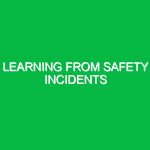Introduction
In the realm of workplace safety, the phrase “Sharing incident learnings within the organization” embodies a critical strategy for improving health, safety, and environmental (HSE) practices. This approach goes beyond mere compliance; it fosters a culture where employees feel empowered to discuss, analyze, and learn from incidents that occur, whether they result in injury or near misses. By creating an environment where knowledge is freely exchanged, organizations can enhance safety protocols, prevent future incidents, and ultimately protect their most valuable asset—people.
Imagine a scenario in a manufacturing plant where an employee slips while carrying a heavy load. Instead of brushing off the incident, the company encourages an open discussion. They analyze the factors that led to the slip, the conditions of the workspace, and the employee’s actions. This incident, if shared properly, can lead to enhanced training, improved safety measures, and a decrease in similar incidents. The relevance of sharing incident learnings cannot be overstated; it not only aids in compliance with safety regulations but also cultivates trust and transparency within the organization.
Identifying Hazards and Risks in Sharing Incident Learnings
While sharing incident learnings serves as a beneficial practice, it does not come without its challenges. Potential hazards and risks associated with this process can emerge if not handled correctly.
1. Miscommunication and Misinterpretation
When sharing learnings, the risk of miscommunication looms large. Different departments might interpret incidents in various ways, leading to inconsistent responses. For instance, if a safety officer relays an incident report without context, employees might draw incorrect conclusions about safety protocols. This highlights the importance of clear and consistent communication.
2. Blame Culture
A significant risk in sharing incident learnings is the potential for a blame culture to develop. If employees fear backlash when discussing incidents, they may withhold critical information. For example, if an employee feels that admitting to a mistake could jeopardize their job, they might remain silent, depriving the organization of valuable insights. Cultivating a non-punitive environment is essential to mitigate this risk.
3. Incomplete Reporting
Another hazard is the possibility of incomplete incident reports. Employees may hesitate to share all details of an incident due to fear of repercussions or embarrassment. Incomplete data can skew analysis and result in inadequate safety measures. Ensuring that reporting systems are designed to prioritize comprehensive information gathering is crucial.
4. Overgeneralization of Learnings
Sometimes, organizations may overgeneralize learnings from incidents. A single incident might lead to sweeping changes that don’t take into account the specific circumstances. For instance, if a safety protocol is altered based solely on one incident, it may not address the root causes effectively. It’s essential to analyze each incident thoroughly before implementing broad changes.
Best Practices for Sharing Incident Learnings
To harness the benefits of sharing incident learnings while minimizing risks, organizations should adopt several best practices.
1. Foster a Just Culture
Emphasizing a just culture is vital. This means creating an environment where employees feel safe to report incidents without fear of punishment. When employees know that the goal is to improve safety rather than assign blame, they are more likely to share their experiences openly.
2. Implement Structured Reporting Mechanisms
Structured reporting mechanisms can help ensure that incidents are documented comprehensively. Utilizing standardized forms can guide employees in providing all necessary details. This approach not only aids in capturing complete information but also facilitates easier analysis later.
3. Conduct Regular Training Sessions
Regular training sessions can reinforce the importance of sharing incident learnings. These sessions should emphasize the value of communication and collaboration in improving safety practices. Incorporating real-life case studies can make these training sessions more impactful. For instance, a construction company might share a video of an incident, discussing what went wrong and how it could have been avoided.
4. Utilize Technology
Leveraging technology can streamline the sharing process. Many organizations now use software that allows employees to report incidents quickly and anonymously. This can encourage participation and lead to a more robust collection of incident learnings. Additionally, organizations can create digital platforms where employees can share insights and resources.
5. Create a Learning Hub
Establishing a centralized repository for incident learnings can facilitate easy access to shared knowledge. This hub can include case studies, incident reports, and best practices. Employees should be encouraged to contribute to this hub, fostering a sense of ownership and collaboration.
Safety Precautions and Actionable Advice
While sharing incident learnings is crucial, it’s equally important to implement safety precautions to protect employees and the organization.
1. Encourage Open Dialogue
Encouraging open dialogue about incidents can help mitigate risks. Regular meetings can provide a forum for employees to discuss safety concerns and share insights. This practice not only strengthens relationships but also builds a safety-first mindset.
2. Ensure Proper Training and Resources
Providing proper training and resources is essential. Employees should be well-versed in safety protocols and incident reporting procedures. By ensuring that everyone understands their role in maintaining safety, organizations can foster a proactive approach to incident prevention.
3. Regularly Review and Update Policies
Organizations should regularly review and update their safety policies based on shared learnings. This can include adjusting training materials, revising safety protocols, and ensuring that all employees are informed about changes. Regular assessments can help identify areas for improvement.
4. Promote a Continuous Improvement Mindset
Promoting a continuous improvement mindset is vital for effective incident learning sharing. Encourage employees to view incidents not as failures but as opportunities for growth. This change in perspective can drive innovation in safety practices and protocols.
Regulations and Standards Governing Incident Learnings
Various regulations and standards govern the sharing of incident learnings within organizations. These guidelines ensure that safety practices are not only effective but also compliant with legal requirements.
1. Occupational Safety and Health Administration (OSHA)
In the United States, OSHA sets forth regulations that mandate employers to maintain safe working conditions. The sharing of incident learnings is a fundamental aspect of these regulations, as it encourages proactive measures to prevent workplace hazards.
2. International Organization for Standardization (ISO) 45001
ISO 45001 outlines criteria for an occupational health and safety management system. This standard emphasizes the importance of continual improvement, which includes sharing incident learnings to enhance safety practices.
3. Industry-Specific Regulations
Many industries also have specific regulations regarding incident reporting and sharing. For example, the oil and gas sector follows strict guidelines for reporting incidents due to the high-risk nature of the work. Familiarity with these guidelines is crucial for organizations operating within such industries.
Conclusion
Sharing incident learnings within the organization is not merely a procedural necessity; it is a transformative practice that can enhance health, safety, and environmental protocols. By fostering a culture of openness, implementing structured reporting mechanisms, and ensuring continuous improvement, organizations can effectively mitigate risks associated with workplace incidents. Furthermore, adherence to established regulations and standards reinforces the importance of this practice.
Real-life experiences, whether through near misses or significant incidents, offer invaluable insights. When organizations prioritize the sharing of these learnings, they not only safeguard their workforce but also cultivate a resilient and safety-conscious culture. As the saying goes, “An ounce of prevention is worth a pound of cure.” Embracing this philosophy will lead to safer workplaces and, ultimately, a more productive and engaged workforce.


